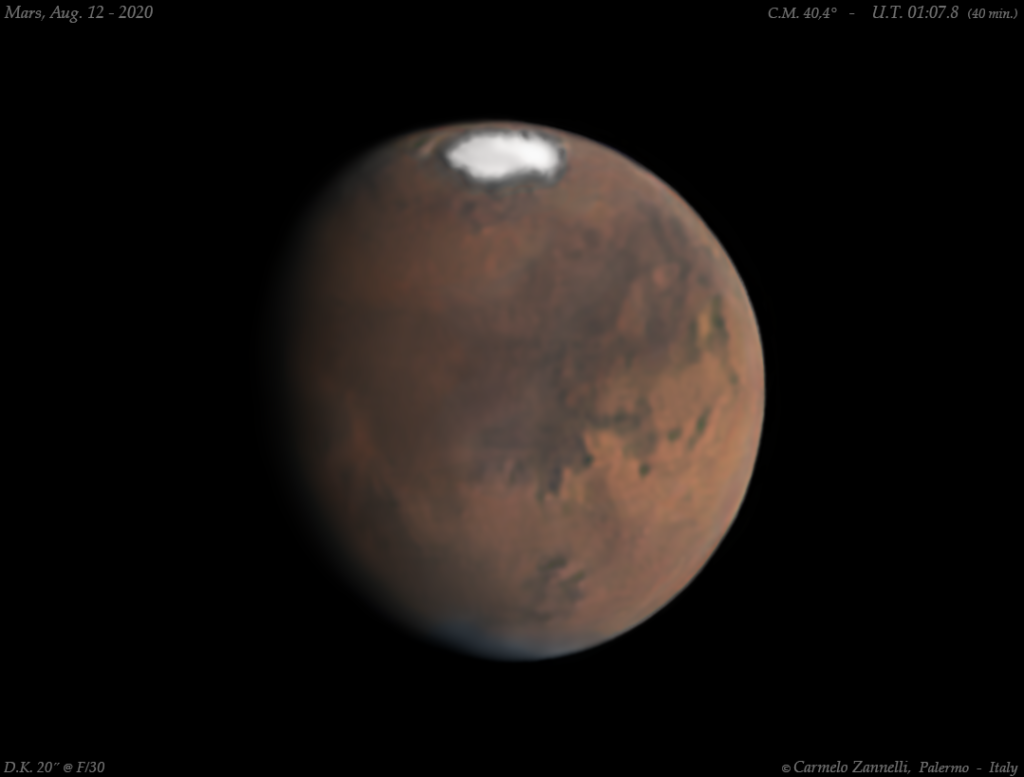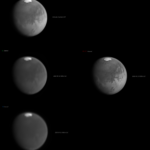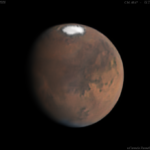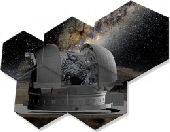Italiano:
In queste notti estive, i pianeti esterni più luminosi Giove, Saturno e Marte (o anche detti Superiori), cioè quelli aventi l’orbita intorno al Sole più esterna rispetto all’orbita terrestre, fanno bella mostra di sè.
Il pianeta Marte quest’anno in particolare, dalle nostre latitudini boreali, sarà molto ben visibile soprattutto quando esso sarà in opposizione al Sole (in Ottobre, quando sarà geometricamente più vicino alla Terra) e sarà più semplice ottenerne immagini in alta risoluzione.
Tuttavia Marte è già ben visibile, nelle tarde ore della notte e all’alba, trovandosi ben posizionato e alto, per gli osservatori boreali.
Questa mia ripresa, di pochi giorni fa – in particolare del 12 agosto scorso -, catturata in condizioni di seeing (di stabilità atmosferica) appena sufficienti, evidenzia anzitutto la “fase” del pianeta.
I pianeti superiori, a differenza di quelli inferiori – aventi l’orbita intorno al Sole più interna di quella terrestre -, possono raggiungere una posizione geometrica di “quadratura” (occidentale o orientale) con la Terra, cioè possono formare un angolo di 90° rispettivamente con la Terra ed il Sole.
Tuttavia, visti dalla Terra, quando sono in “quadratura” non mostrano le evidenti fasi del primo quarto e dell’ultimo quarto, come per la Luna, perchè per una semplice ragione geometrica, Marte e gli altri “pianeti superiori” del sistema solare orbitano intorno al Sole e non intorno alla Terra come fa la Luna, e inoltre raggiungono la quadratura a una distanza dalla Terra molto maggiore di quella della Luna.
In linea generale, quindi, i “pianeti superiori”, mostrano al telescopio un emisfero praticamente pienamente illuminato dal Sole, con l’unica eccezione nella posizione di “quadratura” ma, questa, riguarda in particolar modo solo Marte e, in misura minima, Giove.
Quando, infatti, un “pianeta superiore” è in una delle due posizioni ad angolo retto o “quadrature” con la Terra, si trova nei soli due punti della sua orbita in cui, a causa dell’angolo formato con la Terra e con il Sole, una piccola porzione di esso, dell’emisfero rivolto verso la Terra, non è illuminata dal Sole.
La dimensione angolare di tale porzione diminuisce in funzione della distanza del pianeta in questione dalla Terra, per cui un effetto nettamente e più chiaramente distinguibile dal nostro punto di vista (della superficie terrestre), si ha maggiormente nel caso di Marte, che è il “pianeta superiore” a noi più vicino.
Tornando a questa mia immagine di Marte, al centro di esso è visibile l’area depressionaria di Marte denominata “Eos Chaos”, che è un’area ruvida e collassata nel quadrilatero di “Coprates”, lunga circa 490 km.
Eos Chaos fa parte del più grande sistema di canyon di tutto il sistema solare che attraverserebbe, ad esempio, un’area grande quasi quanto tutti gli Stati Uniti.
Il nome dell’intero sistema di canyon è chiamato “Valles Marineris”, qui visibile iniziando da destra come una sorta di braccio con una mano a tre dita che si estende verso Ovest (qui verso destra per la visione telescopica, che è capovolta).
Partendo da ovest (a destra nell’immagine) con “Noctis Labyrinthus” nel quadrilatero Phoenicis Lacus, il grande sistema di canyon termina nel quadrilatero “Margaritifer Sinus” con “Capri Chasma” ed “Eos Chasma”. La parola “Chasma” è stata designata dall’Unione Astronomica Internazionale per riferirsi a una depressione allungata con lati ripidi.
Ringrazio i miei amici Mario Lauriano per lo spunto critico sulla “fase” di Marte ed il mio caro amico di infanzia, Direttore dell’Istituto di Astronomia e Scienze Planetarie dell’Università di Atacama, Prof. Giovanni Leone, per l’individuazione delle aree e l’analisi su di esse.
Ad maiora…. semper!
Dettagli Tecnici:
Telescopio Astrofaktoria DK20 @ ~ F/30 – Baader-Zeiss Barlow 2x – Schott RG715 filter (IR 715 longpass) – Baader RGB filters – ZWO ASI 290MM camera – Seeing 6/10 in R band – sito: Palermo @ my personal Observatory.
*****************************************************************************************
English:
In these summer nights, the brightest outer planets Jupiter, Saturn and Mars (or also called Superiors), those having the orbit around the Sun more external than the Earth’s orbit, make a fine show of themselves.
The planet Mars, this year particularly well placed for our boreal latitudes, will be very visible especially when it will be in opposition to the Sun (in October, when it will be geometrically closer to the Earth) and it will be easier to obtain high resolution images.
However Mars is already clearly visible, in the late hours of the night and at dawn, being well positioned and high, for boreal observers.
This shot of mine, a few days ago – last August, 12th -, captured in sufficient seeing conditions, first of all highlights the “phase” of the planet.
The superior planets, unlike the inferior ones – having the orbit around the Sun more internal than the terrestrial one -, can reach a geometric position of “quadrature” (western or eastern) with the Earth, that is, they can form an angle of 90 ° with the Earth and the Sun respectively.
However, seen from the Earth, when they are in “quadrature” they do not show the obvious phases of the first quarter and the last quarter as for the Moon, because for a simple geometric reason, Mars and the other “higher planets” of the solar system, orbit around the Sun and not around the Earth as the Moon does, and they also square at a much greater distance from the Earth than the Moon.
In general, therefore, the “higher planets” show to the telescope an hemisphere practically fully illuminated by the Sun, with the only exception in the “square” position but, in particular, it concerns only Mars and, to a minimum extent, to Jupiter.
In fact, when a “higher planet” is in one of the two positions at right angles or “squares” with the Earth, it is found only in the two points of its orbit in which, due to the angle formed with the Earth and with the Sun, a small portion of it isn’t illuminated by the Sun.
The angular dimension of this portion decreases as a function of the distance of the planet in question from the Earth, so an effect that is clearly and more clearly distinguishable from our point of view (of the Earth’s surface), is more in the case of Mars, which is the ” higher planet “closest to us.
Returning to my image of Mars, in the center of it is visible the depression area of Mars called “Eos Chaos”, which is a rough and collapsed area in the quadrilateral of “Coprates”, about 490 km long.
Eos Chaos is part of the largest canyon system in the entire solar system that would cross, for example, an area nearly the size of the entire United States.
The name of the entire canyon system is called “Valles Marineris”, visible here as a kind of arm with a three-fingered hand extending to the right.
Starting from the west (right in the image) with “Noctis Labyrinthus” in the “Phoenicis Lacus” quadrilateral, the great canyon system ends in the “Margaritifer Sinus” quadrilateral with “Capri Chasma” and “Eos Chasma”. The word “Chasma” has been designated by the International Astronomical Union to refer to an elongated depression with steep sides.
Ad maiora…. semper!
Technical details:
Astrofaktoria telescope DK20 @ ~ F / 30 – Baader-Zeiss Barlow 2x – Schott RG715 filter (IR 715 longpass) – Baader RGB filters – ZWO ASI 290MM camera – Seeing 6/10 in R band – site: Palermo @ my personal Observatory.




2 Comments
Fantastique image Carmelo, l’opposition martienne risque d’être incroyable avec ton tube, un grand bravo !
Merci beaucoup William, je vais certainement essayer! 🙂